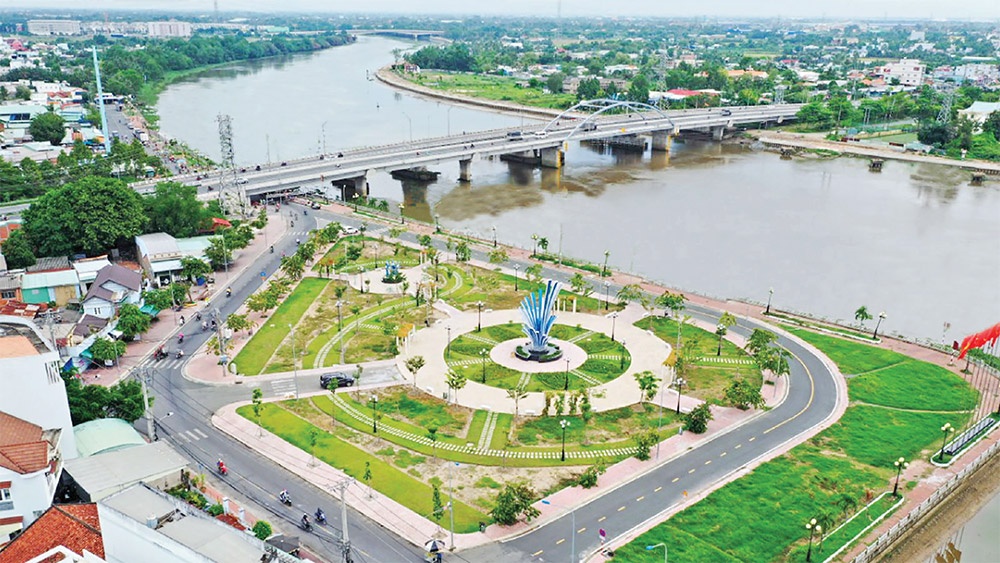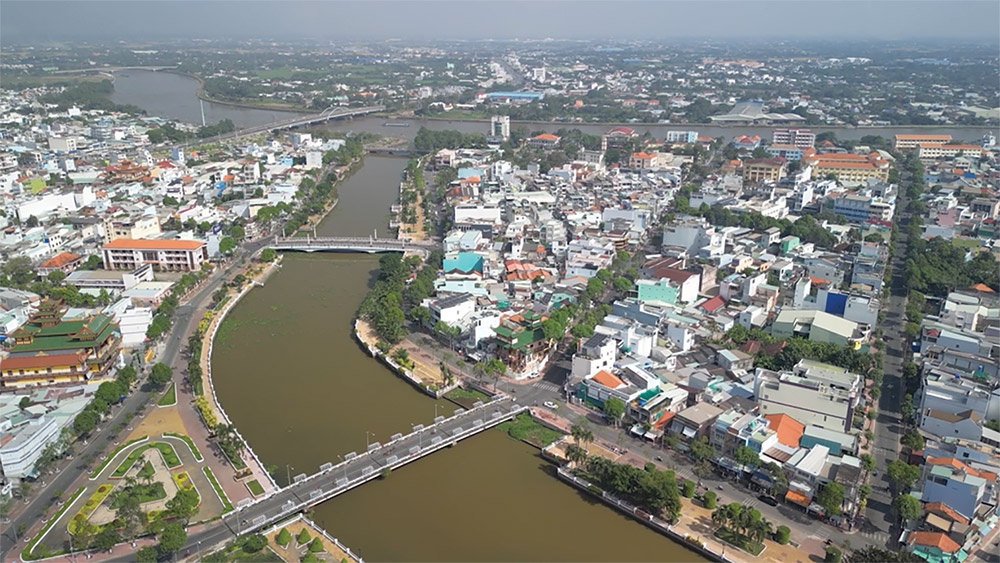Long An embraces technical and social urban perspective
Long An embraces technical and social urban perspective
Long An province is gearing up its efforts to develop a sustainable, ecological, and smart urban system by the end of the decade.

Long An is completing urban classification criteria regarding infrastructure and transportation system, Photo: Long An Radio - Television Station
Long An, a neighbouring province of Ho Chi Minh City, is experiencing a rapid urbanisation rate as the gateway connecting the municipal city with the Mekong Delta and Southeast region. The locality also converges many important national traffic routes, such as national highways 1 and 50, and Ho Chi Minh City ring roads 3 and 4.
The province has become one of the most vibrant real estate markets in the south in recent years. Many leading real estate developers have invested in a slew of ventures in the locality, ranging from urban areas to residential areas and various types of housing, such as apartments and villas.
Notably, Nam Long Group, in collaboration with Japanese partner Nishi Nippon Railroad, is developing Waterpoint Township in Ben Luc district. Meanwhile, T&T Land, a member of T&T Group, is investing in the T&T City Millennia venture in Can Giuoc district.
Another investor, Green City Development JSC, a subsidiary of Vinhomes, is building Vinhomes Green City in Duc Hoa district, which is expected to accommodate 40,000 residents and cost over $1 billion.
Furthermore, Long An is one of the top localities for attracting industrial real estate ventures. The province has a plan to develop 51 industrial parks across an area over 12,400 hectares. So far, 37 have been established, with a total area of 10,000ha. Among them, 26 are eligible to receive investors, with an occupancy rate of 69 per cent.
Industrial areas not only attract investment effectively with a high occupancy rate, but also draw a large number of workers from both inside and outside the locality. As of May, there are around 1,670 enterprises operating in local industrial areas, employing almost 198,000 workers. This has expedited the progress of urban development, trade, and services.
Developing sustainable urban areas
Special attention has been paid to urban management, planning, and development in the locality in recent years. The goals are to develop urban areas, improve residents’ quality of life, and change the appearance of the urban landscape towards a civilised, modern, effective, and sustainable model, while preserving cultural identity.
The provincial urban development programme to 2025, with a vision to 2030, proposes priority investment items and capital demand forecasts. It also covers the classification of investment capital sources according to stages for framework infrastructure development projects connecting urban areas, as well as development ventures in each urban area.
A focus is given to upgrading urban areas, improving national highway traffic infrastructure, and adding public facilities to unlock the locality’s potential.
The urban system plan is also outlined in the master development plan of Long An for the 2021-2030 period, with a vision to 2050. Under the master plan, Long An formulates policies to encourage the development of a harmonious urban system in line with the potential and advantages of each urban area.
The province not only makes efficient and economical use of land, but also strongly develops urban areas near Ho Chi Minh City and the centre of the Dong Thap Muoi region. This is coupled with expanding the scope and boundaries of existing urban areas that do not meet area standards.
It is necessary to ensure a natural area of 150sq.km or more for Tan An City, with priority given to urban expansion towards the northeast and southeast directions, associated with the southern development corridor.
In line with Long An’s master plan, the province aims to develop an urban system consisting of 27 urban areas by 2030. One will feature first-tier status (Tan An city), one second-tier (Kien Tuong town), three third-tier (Ben Luc, Can Giuoc, and Duc Hoa), nine fourth-tier, and the remainder fifth-tier status. Among them, Tan An city is designated as the centre of commerce, services, and high-tech industries in the northeast of the Mekong Delta, as well as a gateway city between the southeast region and the Mekong Delta.
Long An has set several goals for urban system development by 2030. Specifically, the urbanisation rate is expected to reach around 55 per cent. All urban areas of third-tier or higher will complete urban classification criteria regarding infrastructure, especially for healthcare, education, training, and urban cultural works.
To ensure the sustainable development of urban areas, the province aims to accelerate the speed and improve the quality of urbanisation, develop sustainable urban networks, and form several dynamic smart urban areas that connect with the region, the country, and the world. Urbanisation and urban development are expected to become driving forces for the province’s socioeconomic development.

In line with Long An’s master plan, the province aims to develop around 27 urban areas by 2030, Photo: LA34
Positive outcomes
In recent times, Long An People’s Committee has actively directed departments and the people’s committees of districts, towns, and cities to review planning projects. The provincial authority has issued an action programme and relevant plans to formulate planning, architectural management regulations, urban development initiatives, and urban classification projects in Long An during the 2024-2030 period.
Remarkable results in urban classification have been achieved. Before 2016, Long An had only 17 urban areas, encompassing one third-tier urban area, five fourth-tier urban areas, and 11 fifth-tier urban areas. Today, the province is home to 19 urban areas, including second-tier Tan An city and third-tier Kien Tuong town.
At present, Long An has achieved positive results in urban development according to the set requirements. Urban spaces are increasingly being improved and expanded, in line with the local socioeconomic context. The province’s urban landscape has seen marked changes towards a green, clean, spacious, and modern appearance, contributing to enhancing residents’ quality of life. Architectural highlights have been built to beautify the landscape, such as squares, green parks, public areas, and median strips along the main roads.
Additionally, urban infrastructure – especially technical and essential social infrastructure – is being developed in a synchronous and modern manner. The urban economy is undergoing rapid, effective, and sustainable growth. Urban dwellers enjoy a high quality of life, as their basic housing and social infrastructure needs are being met. In addition to the development of modern, green, smart, and distinctive urban architecture, typical cultural elements are being preserved and promoted.
Much attention is also being paid to smart urban areas in Long An, with a focus on high connectivity, sustainability, and efficiency. Putting people at the centre, smart urban areas are designed based on residents’ actual needs, ensuring that all residents can benefit from urban development.
Web Site : sensors.sciencefather.com
Visit Web Site : sciencefather.com
Nomination Link : https://sensors-conferences.sciencefather.com/award-nomination/?ecategory=Awards&rcategory=Awardee
Contact as : sensor@sciencefather.com
Social Media
Twitter :https://x.com/sciencefather2
Pinterest : https://in.pinterest.com/business/hub/
Linkedin : https://www.linkedin.com/feed/
Nomination Link : https://sensors-conferences.sciencefather.com/award-nomination/?ecategory=Awards&rcategory=Awardee
Contact as : sensor@sciencefather.com
Social Media
Twitter :https://x.com/sciencefather2
Pinterest : https://in.pinterest.com/business/hub/
Linkedin : https://www.linkedin.com/feed/
you tube: https://www.youtube.com/@sensorconferenceawards/community
#ScienceFather, #AirPollution,#AcousticBlackHole, #ABH, #WaveAbsorption, #SoundDamping, #VibrationControl, #PassiveDamping, #StructuralAcoustics, #FlexuralWaves, #NoiseReduction, #AcousticEngineering #EnvironmentalSensors #ActOnPollution, #FightAirPollution, #StopAirPollution, #SmogAlert, #AirCrisis #SemiconductorDevices, #SustainableEnergy, #GreenEnergy, #RenewableEnergy #NoiseImpact #ClimateMonitoring, #SmartHomes, #TemperatureControl, #PredictiveMaintenance, #MachineLearningSensors, #AIinMonitoring, #MedicalTemperatureMonitoring, #WeatherMonitoring, #SmartAgriculture, #FoodSafetyMonitoring, #EnergyEfficiency #PostHumanEra, #TechEvolution, #HumanCenteredAI, #SmartAugmentation #AdvancedRobotics, #BestRoboticsTech, #RoboticsResearch, #NextGenSensors, #IoTSensors, #SensorAwards, #RobotPerception, #ArtificialIntelligence, #SensorIntegration, #EnergyTransition #Electromagnetism #AnalyticalSolutions #RoboticMobility #GeckoInspiredRobot #IndustrialInspection #EconomicResearcher, #PublicHealthResearcher, #Anthropologist, #Ecologist,
#ScienceFather, #AirPollution,#AcousticBlackHole, #ABH, #WaveAbsorption, #SoundDamping, #VibrationControl, #PassiveDamping, #StructuralAcoustics, #FlexuralWaves, #NoiseReduction, #AcousticEngineering #EnvironmentalSensors #ActOnPollution, #FightAirPollution, #StopAirPollution, #SmogAlert, #AirCrisis #SemiconductorDevices, #SustainableEnergy, #GreenEnergy, #RenewableEnergy #NoiseImpact #ClimateMonitoring, #SmartHomes, #TemperatureControl, #PredictiveMaintenance, #MachineLearningSensors, #AIinMonitoring, #MedicalTemperatureMonitoring, #WeatherMonitoring, #SmartAgriculture, #FoodSafetyMonitoring, #EnergyEfficiency #PostHumanEra, #TechEvolution, #HumanCenteredAI, #SmartAugmentation #AdvancedRobotics, #BestRoboticsTech, #RoboticsResearch, #NextGenSensors, #IoTSensors, #SensorAwards, #RobotPerception, #ArtificialIntelligence, #SensorIntegration, #EnergyTransition #Electromagnetism #AnalyticalSolutions #RoboticMobility #GeckoInspiredRobot #IndustrialInspection #EconomicResearcher, #PublicHealthResearcher, #Anthropologist, #Ecologist,
.jpg)
Comments
Post a Comment